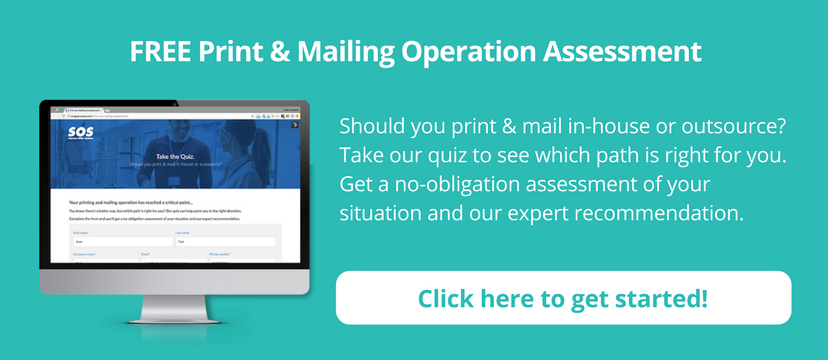Tips for Setting Up an In-House Print Production Process
Last week, we discussed how you can benefit from doing your print production and mailing in house. We also looked at the types of pieces you can produce with the right production print process, equipment and software.
In case you missed it, read this: Why Bring Print Production & Mailing In House?.
Setting up an internal print production process is not right for everyone. Take our free quiz to find out if outsourcing or in-house production is the better choice for you.
Now let’s talk about how to set up your own cost-effective production print process and operation.
STEP 1: What materials do you want to print?
Believe it or not, people tend to overlook this critical step when establishing a print production process and operation.
For example, a marketing manager may be looking to produce sales and marketing materials. However, there may be other departments within the organization that do a lot of printing… or pay a lot to outsource that printing. Accounting may print & mail thousands of invoices every month. Human resources may need benefits enrollment materials. The list goes on.
When you understand ALL your needs for high-volume and high-quality printing, you can factor those needs into your production print process and equipment decisions. Doing so sets you up as the hero who reduced printing and mailing costs across the organization.
STEP 2: What will you need to produce those materials?
At this stage, you may begin to research printing equipment. However, it’s important to think about other resources you’ll need for setting up your internal production print process and operation.
For example, do you have the space needed to set up a central reprographics department (CRD)? Or will you need to get additional space for equipment and processing?
Don’t forget to think about mailing the printed materials you produce. Do you already have a mailroom? If so, you may need to upgrade equipment to handle the increased volume. If not, you’ll probably need to set up this capability. Read this to learn more: Does your business need a mailroom?
Expertise is another critical resource. The good news is, production printing equipment has become so much easier to operate. Many CRDs only need a single key operator to run the equipment. However, you’ll also need to design pieces, manage data and mailing lists, and manage your internal production print process. If you don’t currently have the expertise needed for these tasks, be sure to factor in the cost of training or additional staff.
STEP 3: Develop your production print process & workflow
An efficient and effective production print process is all about developing the right workflow. Before you make a decision about equipment, it’s important to understand how you plan to:
- Take print orders
- Prioritize jobs
- Handle approvals
- Track and communicate job status
- Test printed materials for consistent quality
- Deliver completed jobs
- Order supplies
The point is, you need to plan your production print workflow BEFORE you select the right equipment and software for the job.
Here are a couple of important tips and resources that can help you put together your production print process.
Create a web-based print order submission process. Trying to process print orders with a file on a memory stick and instructions scribbled on a piece of paper is time-consuming and prone to error. Read this to learn more: 11 Reasons to Implement Print Workflow Automation for Job Submission.
Automate your print production process as much as possible. Print workflow automation software makes that easy. Doing so reduces mistakes, speeds processing and cuts costs. Read this to learn more: How to Speed Prepress Workflow for 6 Challenging Job Types.
Don’t worry if you’re not an expert on the production print process just yet! The experts at Superior Office Systems and Canon (the print production industry leader) and answer your questions and guide you through the process. We’re here to help, so feel free to reach out for a no-obligation consultation.
STEP 4: Select equipment and software
Now that you have a better idea what you need, you’re ready to choose production print equipment and software.
Here are just a few capabilities you must factor into your decision:
Paper. What types of paper do you need to print on? Can the machines handle the sizes, weights and finishes you want to use?
Speed and volume. Can the machines produce the volume of printed materials in the required timeframe?
Finishing. What type of finishing capabilities do you need? Consider stapling, binding, hole punching, trimming and more.
Personalization. Can the equipment and software do variable data printing? Especially for sales and marketing materials, shorter print runs with more personalization are becoming the norm. Even if you’re not doing it yet, it’s smart to plan ahead for this capability that can greatly increase engagement.
Mailroom equipment. As we mentioned earlier, do you have the postage machines, inserters, and sorters needed to process mailing of your printed pieces?
As you evaluate equipment options, you might want to create a production print checklist that prioritizes your must-haves and your wish list. That can help you make the best choice and stay within your budget.
SERVICE. Don’t underestimate the value of good service for production print equipment. It’s easily as important as the equipment itself. Learn more from this helpful guide: How to Evaluate Digital Press Service BEFORE You Buy.
STEP 5: Promote, track and improve
Once you’re up and running, there’s more you can do to get the most from your print production process and operation.
1. Promote. Make sure everyone in your organization knows you can now produce their printed materials internally. Explain the cost benefit, the process, and what types of jobs you can print. There’s nothing worse than going through the effort and expense of setting up a production print process and operation, only to have people continue wasting money by outsourcing their work.
2. Track. With the right automation and software, you have access to all kinds of cost and production analytics. Take advantage of these to track how your operation is performing.
3. Continuously improve. When the analytics reveal areas of your print production process that need improvement, get on that right away. Your automation software can help with that. Learn more: 6 Steps to Improve Your Digital Press Workflow.




